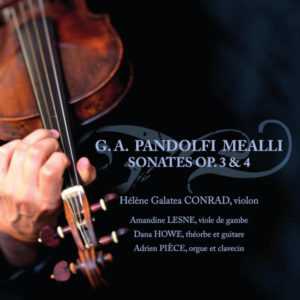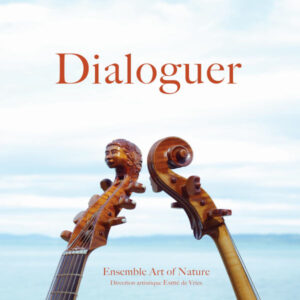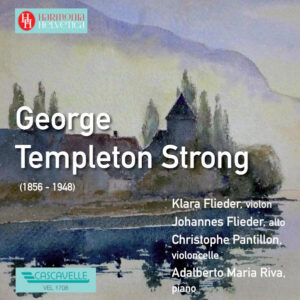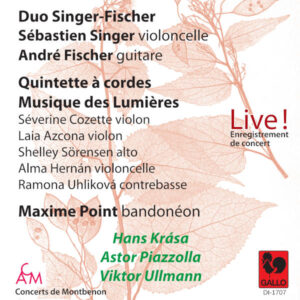Extraits / Excerpts
MENDELSSOHN : STRING QUARTET NO. 1, OP. 12 – STRING QUARTET NO. 2, OP. 13 – CAPRICCIO, OP. 81 – QUATUOR SINE NOMINE
Felix MENDELSSOHN : String Quartet No. 1 in E-Flat Major, Op. 12, MWV R25: I. Adagio non troppo – Allegro non tardante – II. Canzonetta – Allegretto – Più mosso – III. Andante espressivo – IV. Molto allegro e vivace – String Quartet No. 2 in A Minor, Op. 13, MWV R22: I. Adagio – II. Adagio non lento – III. Intermezzo – Allegro con moto – Allegro di molto – IV. Presto – Adagio non lento – 4 Pieces for String Quartet, Op. 81, MWV R32: III. Capriccio.
Quatuor Sine Nomine : Patrick Genet, François Gottraux, Violins – Nicolas Pache, Viola – Marc Jaermann, Cello.
From Richard Wagner’s vile anti-Semitic declarations to Debussy’s description of him as an « elegant, shallow notary », Mendelssohn has, for more than a century, been the constant victim of an inexplicable compaign of calumny. Perhaps envy on the part of his detractors at his joie de vivre, handsomeness, comfortable social status or the incredible ease with which he was able to create.
A certain number of Mendelssohn’s works have always been favorites with audiences : Hebrides, a Midsummer night’s dream, Concerto for violin or his Italian Symphony. However, concertgoers are generally unaware of Mendelssohn’s chamber music preferring Mozart’s or Beethoven’s to his quartets.
A great devotee of classicism, Mendelssohn was to infuse his quartets with a limpidity recalling that of Mozart. He composed his Quartet in A minor, Op. 13 between July and October 1827. This unjustly neglected work reveals the perfect stylistic mastery of the then eighteen-year-old composer, inspired perhaps in his creation by Beethoven’s death. While Mendelssohn did not attempt to imitate the great master in this work, its structure is clearly influenced by the late quartets of Beethoven.
The opening movement of Opus 13 is based on a motif from his lied Op .9, No.1 Ist es wahr ?, which serves as a central strand weaving its way throughout. The second movement is developed with taut chromatism, terminating in a four-part fugue in which certain elements of the finale are already perceptible. The intermezzo which follows is a perfect example of Mendelssohn’s art, and, at the same time, of that care-free elegance for which he has so often been criticized. The finale is one of the most highly complex movements composed by the youthful Mendelssohn, being continually interrupted by a recitative in which the lied’s initial motif is heard once more. Doesn’t this almost obsessive repetition of Ist es wahr ? bear an uncanny resemblance to Beethoven’s Muss es sein ? Es muss sein !
Mendelssohn completed his Quartet No. 1 in E Flat, Op.12 two years later, in September 1829. This work opens with a brief slow introduction, followed by a sprightly allegro whose development is rather lengthy. In lieu of the usual slow second movement, Mendelssohn substitutes a delightful canzonet, which is often performed separately. Light, flowing and charming in its simplicity, this ethereal piece bears the stamp of Mendelssohn’s musical genius as well. The subsequent andante espressivo features the first violinist in a great flight of lyricism.
During its finale, the work rushes forward – as if its composer wished to carry us off on a kind of musical horseback ride – in a style highly reminiscent of Schubert’s. As in the case of the finale of Opus 13, here Mendelssohn adopts the same cyclical structure, with the conclusion of the work containing various elements of its first movement.
Mendelssohn’s Capriccio in E minor, Op.81, No.3 originally formed the third movement of Quartet No.7, put together arbitrarily, following the death of the composer, from four separate works of his for a string quartet. This short piece consists of two parts fused together. The andante movement, a song without words, is followed by a particularly energetic allegro fugato with tightly-woven counterpoint, as though Mendelssohn were attempting to unite lied and scherzo into a new musical form somewhere between the two.
François Hudry
transl. Gary Lebowitz
- Categories
- Composers
- Interprets
- Booklet












